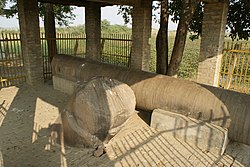Nigali Sagar
| Nigali Sagar pillar of Ashoka | |
|---|---|
 The Nigali Sagar pillar, one of the pillars of Ashoka. | |
| Material | Polished sandstone |
| Size | Height: Width: |
| Period/culture | 3rd century BCE |
| Discovered | 27°35′41.7″N 83°05′44.9″E / 27.594917°N 83.095806°ECoordinates: 27°35′41.7″N 83°05′44.9″E / 27.594917°N 83.095806°E |
| Place | Nigalihawa, Nepal. |
| Present location | Nigalihawa, Nepal. |
 Nigali Sagar | |
Nigali Sagar (also called Nigliva,[1] Nigali Sagar pillar, Nighihawa pillar, Nigliva pillar, or Araurakot pillar) is an archaeological site in Nepal containing the remains of a pillar of Ashoka. The site is located in Nigalihawa, about 20 kilometers northwest of Lumbini and 7 kilometers northeast of Taulihawa.[2] Another famous inscription discovered nearby in a similar context is the Lumbini pillar inscription.
Discovery[]
The pillar was discovered in 1893 by a Nepalese officer on a hunting expedition.[3][4] The pillar and its inscriptions (there are several inscriptions on it, from Brahmi to Medieval) were researched in March 1895 by Alois Anton Führer. Führer published his discovery in the Progress Report of the Archaeological Survey Circle, North-West Province, for the year ending on June 30, 1895.[1] The fact that the inscription was discovered by Führer, who is also known to have forged Brahmi inscriptions on ancient stone artefacts, casts a doubt on the authenticity of this inscription.[5]
The pillar was not erected in-situ, as no foundation has been discovered under it. It is thought that it was moved about 8 to 13 miles, from an uncertain location.[7]
Besides his description of the pillar, Führer made a detailed description of the remains of a monumental "Konagamana stupa" near the Nigali Sagar pillar,[8] which was later discovered to be an imaginative construct.[9] Furher wrote that "On all sides around this interesting monument are ruined monasteries, fallen columns, and broken sculptures", when actually nothing can be found around the pillar.[10] In the following years, inspections of the site showed that there were no such archaeological remains, and that, in respect to Fuhrer's description "every word of it is false".[11] It was finally understood in 1901 that Führer had copied almost word-for-word this description from a report by Alexander Cunningham about the stupas in Sanchi.[12]
Kanakamuni Buddha[]




